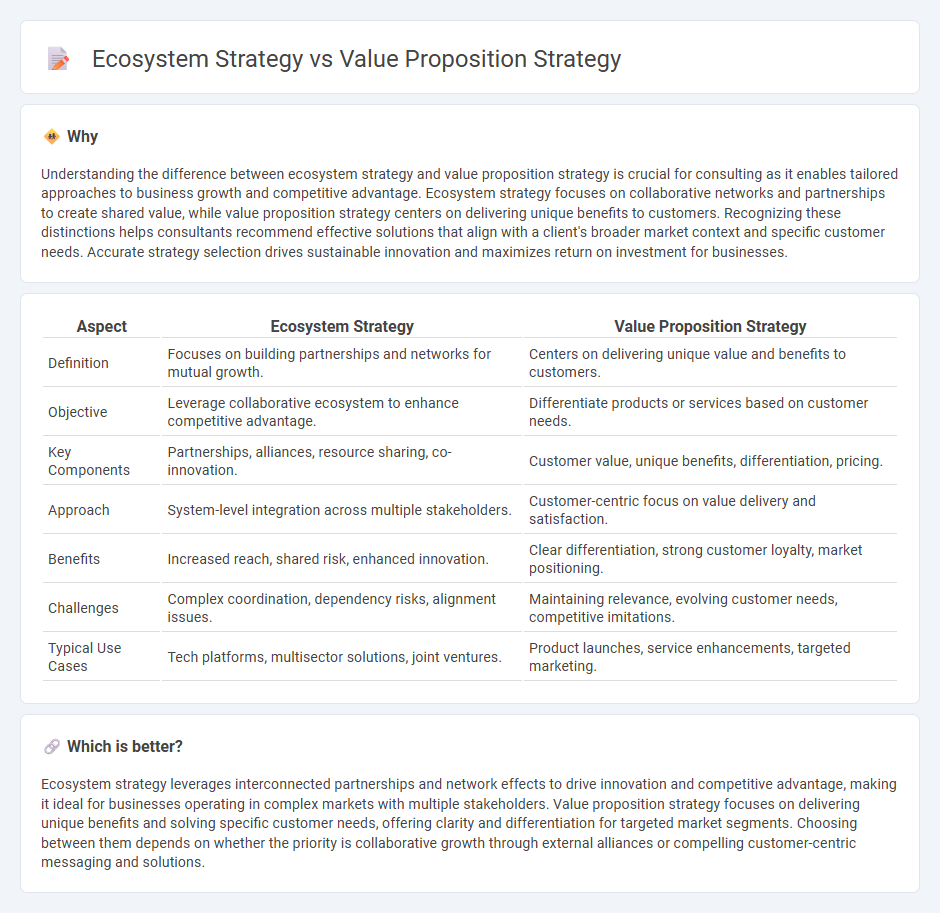
Ecosystem strategy focuses on creating interconnected networks of partners and stakeholders to enhance collaboration and drive collective growth, leveraging diverse capabilities and resources. Value proposition strategy centers on clearly defining the unique benefits and solutions a company offers to its target customers, aiming to differentiate from competitors and maximize customer satisfaction. Explore how integrating both strategies can optimize business performance and competitive advantage.
Why it is important
Understanding the difference between ecosystem strategy and value proposition strategy is crucial for consulting as it enables tailored approaches to business growth and competitive advantage. Ecosystem strategy focuses on collaborative networks and partnerships to create shared value, while value proposition strategy centers on delivering unique benefits to customers. Recognizing these distinctions helps consultants recommend effective solutions that align with a client's broader market context and specific customer needs. Accurate strategy selection drives sustainable innovation and maximizes return on investment for businesses.
Comparison Table
| Aspect | Ecosystem Strategy | Value Proposition Strategy |
|---|---|---|
| Definition | Focuses on building partnerships and networks for mutual growth. | Centers on delivering unique value and benefits to customers. |
| Objective | Leverage collaborative ecosystem to enhance competitive advantage. | Differentiate products or services based on customer needs. |
| Key Components | Partnerships, alliances, resource sharing, co-innovation. | Customer value, unique benefits, differentiation, pricing. |
| Approach | System-level integration across multiple stakeholders. | Customer-centric focus on value delivery and satisfaction. |
| Benefits | Increased reach, shared risk, enhanced innovation. | Clear differentiation, strong customer loyalty, market positioning. |
| Challenges | Complex coordination, dependency risks, alignment issues. | Maintaining relevance, evolving customer needs, competitive imitations. |
| Typical Use Cases | Tech platforms, multisector solutions, joint ventures. | Product launches, service enhancements, targeted marketing. |
Which is better?
Ecosystem strategy leverages interconnected partnerships and network effects to drive innovation and competitive advantage, making it ideal for businesses operating in complex markets with multiple stakeholders. Value proposition strategy focuses on delivering unique benefits and solving specific customer needs, offering clarity and differentiation for targeted market segments. Choosing between them depends on whether the priority is collaborative growth through external alliances or compelling customer-centric messaging and solutions.
Connection
Ecosystem strategy and value proposition strategy are interconnected through their focus on creating competitive advantage by leveraging partnerships and delivering unique customer value. The ecosystem strategy enables companies to collaborate with multiple stakeholders, enhancing resource sharing and innovation, which strengthens the overall value proposition offered to customers. This integrated approach drives market differentiation and sustainable growth by aligning complementary assets and capabilities around a compelling customer-centric value proposition.
Key Terms
Differentiation
Value proposition strategy centers on delivering unique features or benefits to differentiate a product or service from competitors, aiming to attract specific customer segments through tailored solutions. Ecosystem strategy focuses on creating interconnected networks of partners, technologies, and services that collectively enhance value, fostering differentiation through collaborative innovation and comprehensive customer experiences. Explore how combining both strategies can amplify competitive advantage in dynamic markets.
Partnerships
Value proposition strategy centers on delivering unique benefits directly to customers by tailoring offerings to meet specific needs and preferences. Ecosystem strategy emphasizes building a network of partnerships that create mutual value, enabling participants to leverage shared resources and innovation. Explore how aligning partnerships within these strategies can drive competitive advantage and growth opportunities.
Synergy
Value proposition strategy emphasizes creating unique benefits and solutions tailored to customer needs, enhancing competitive advantage through clear and compelling offers. Ecosystem strategy leverages collaboration among interconnected partners, fostering synergy to drive innovation, resource sharing, and market expansion. Explore in-depth insights on maximizing synergy through strategic alignment and integrated value creation for sustained growth.
Source and External Links
Value Proposition - A Comprehensive Guide - Intrafocus - A value proposition strategy involves identifying target customers, understanding their key problems, and communicating a unique, clear, and persuasive message that highlights how a product or service uniquely solves those problems better than competitors.
Unique Value Proposition - Institute For Strategy And Competitiveness - The value proposition strategy defines the specific value a company creates for customers, often by segmenting or expanding the market with a novel approach, focusing on demand and customer needs outside internal operations.
How To Write a Compelling Value Proposition: 5 Examples (2025) - Shopify - A successful value proposition strategy ensures the proposition is specific about the benefits, pain-focused on solving customer problems, and exclusive by emphasizing competitive advantage to clearly promise superior outcomes after purchase.
 dowidth.com
dowidth.com